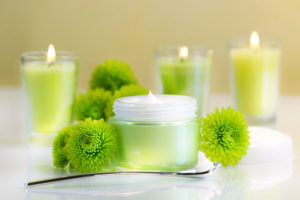 Free radical reactions are ubiquitous in biological systems and the multiple defence systems in all living organisms surely testify the evolutionary importance of these reactions.
Free radical reactions are ubiquitous in biological systems and the multiple defence systems in all living organisms surely testify the evolutionary importance of these reactions.
Nevertheless, an excess in extrinsic free radicals may overload the intrinsic defence mechanisms. Especially the skin is exposed on a daily basis to extrinsic factors that directly or indirectly cause the generation of free radicals in the living layers of this organ. Among the sources of radical generation, mainly UV radiation and toxic and phototoxic agents are the most frequent factors for human skin. An excessive exposure to radiation, i.e. due to excessive sun bathing, will lead to exploitation of the organism’s defence system. The impact of the extrinsic pro-oxidative factors can be influenced by the application of cosmetic products.
Indeed, there is no placebo in dermatology; meaning that everything that we are applying on our skin will have an influence. Especially cosmetic products often contain ingredients that may alter the skin’s response toward extrinsic oxidative stress. The following examples may explain the concept:
-Certain antioxidants (i.e. vitamin C, vitamin E, certain polyphenols) react with a radical intermediate. These intermediates may act as radical boosters under UV-radiation.
-Photo-unstable UV filters or combinations may enhance the peroxide radical concentration in a cosmetic preparation when applied on the skin.
-Moisturizing effects may influence the radical status of skin during UV radiation, by increasing the penetration of UV rays in the deeper layers of the skin. The higher the hydration of a skin, the higher is the potential risk for free radical formation (1).
-The elution of some ingredients from the packaging into the cosmetic formulation may enhance the risk of contamination with potential photosensitizers.
-Perfumes are among the ingredients with the highest risk of peroxide radical contamination. Radical chain reactions may occur under UV-radiation.
-Unsaturated fatty acid components, in either natural oils or emulsifiers, may enhance the risk of lipid peroxidation via epoxide formation under UV light.
-Other actives may influence the radical status of the skin by different mechanisms. I.e. glycation agents may cause cross-links and radical intermediates (2,-4).
It is to be emphasised that none of the above ingredients are harmful as such. Only in the presence of an external stressor (in the specific case UV light) they can enhance the negative impact of the radiation. This is why the screening of products’ efficacy and safety should be executed following the concept of a stress testing. A stress testing is a form of deliberately intense or thorough testing used to determine the stability of a given system or entity. It involves testing beyond normal operational capacity, often to a breaking point, in order to observe the results.
Since the previously mentioned examples all involve the formation of free radicals, it is reasonable to use the quantification of UV-induced free radicals inside the skin as an endpoint result for the stress testing. Electron Spin Resonance (ESR) spectroscopy based methodologies allow to quantify these free radicals directly inside full thickness skin biopsy samples or directly inside the cosmetic formulation. The determination of UV-induced free radicals inside the skin is realised by the Radical Skin Protection Factor (RSF) and the determination of UV-induced free radicals inside a cosmetic formulation is realised by the Radical Potential (RP).
Both methods allow a rapid and quantitative analysis on the impact of raw materials or final products under realistic conditions. The UV doses applied on the skin or on the product are equivalent to 1-2 MED (medium erythema dosis) and the UV source is a Sun simulator. Standards and Calibrators are used to quantify the amount of UV-induced free radicals and to guarantee a highly sensitive and reproducible methodology.
RSF ~ N (free radicals in untreated skin)
N (free radicals in treated skin)
RP ~ N (free radicals in reference cosmetic)
N (free radicals in reference cosmetic + ingredient)
Both methods offer the possibility to be used for market claim substantiation. All kind of cosmetic raw materials and all kind of cosmetic products (sunscreens, anti-ageing, day care, night care, self-tanners) can be analysed.
References
(2) K Jung, M Seifert, T Herrling, J Fuchs. UV-generated free radicals (FR) in skin: Their prevention by sunscreens and their induction by self-tanning agents. Spectrochim Acta A Mol Biomol Spectrosc. 2007.
(3) GT Wondrak, EL Jacobson, MK Jacobson. Photosensitization of DNA damage by glycated proteins. Photochem. Photobiol. Sci., 2002,1, 355-363.
(4) RV Lloyd, AJ Fong, RM Sayre. In vivo formation of Maillard reaction free radicals in mouse skin. J Invest Dermatol. 2001; 117: 740-742.
(5) U Osterwalder, K Jung, M Seifert, Th Herrling. Importance of UVA Sun Protection: A Comparative Analysis of Different Quality Control Methods
SÖFW-Journal 135/ 9/2009 2-13.
(6) C Kandzia, K Jung, M Seifert, T Herrling, H Flößer-Müller, S Champ. Strategy for efficient prevention from photo-ageing, SÖFW Journal 134 8/2008, 23 – 32.
By Katinka Jung, Pietro Abba, Enzo Biraghi

